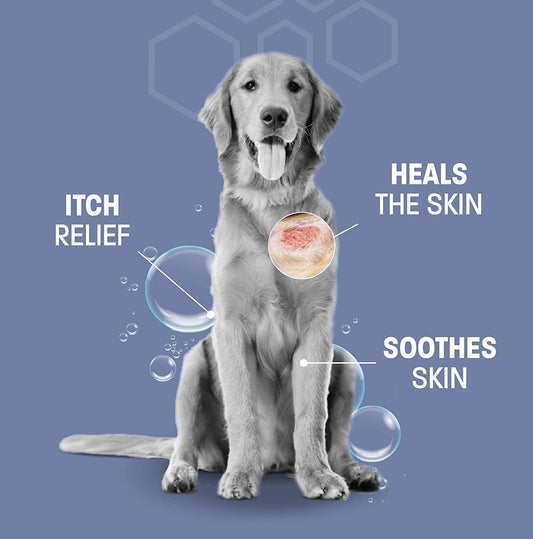Dog yeast infection in the feet can be a frustrating and uncomfortable condition for your furry friend. It is important to understand the causes, symptoms, diagnosis, and treatment options for this condition in order to effectively manage it. In this article, we will explore these key aspects and provide helpful tips to help your dog find relief.
Key Takeaways
- Yeast infections in a dog's feet can be caused by a variety of factors, including allergies, moisture, and immune system issues.
- Common symptoms of dog yeast infection in the feet include itching, redness, swelling, and a foul odor.
- A veterinarian can diagnose a dog yeast infection in the feet through a physical examination, skin scraping, and laboratory tests.
- Treatment options for dog yeast infection in the feet may include medicated shampoos, topical antifungal creams, oral medications, and dietary changes.
- Preventing dog yeast infection in the feet involves keeping the paws clean and dry, avoiding allergens, and maintaining a healthy immune system.
Understanding Dog Yeast Infection in the Feet
Causes of Dog Yeast Infection in the Feet
Dog yeast infection in the feet can be caused by various factors. One common cause is excessive moisture in the paws, which creates an ideal environment for yeast to grow. Other causes include allergies, weakened immune system, and synthetic dog cologne. It's important to note that using synthetic dog cologne can disrupt the natural balance of bacteria and yeast on the skin, leading to an overgrowth of yeast. Therefore, it's best to avoid using such products on your dog's feet.
Symptoms of Dog Yeast Infection in the Feet
Symptoms of dog yeast infection in the feet can vary depending on the severity of the infection. Common signs include itching, redness, swelling, and discharge. Dogs may also experience licking or chewing of the affected area. In some cases, dogs may develop hot spots on their feet, which are painful, inflamed areas that can become infected. If you notice any of these symptoms, it is important to consult with your veterinarian for a proper diagnosis and treatment plan.
Diagnosing Dog Yeast Infection in the Feet
Diagnosing a dog yeast infection in the feet can be done through a combination of physical examination and laboratory tests. A veterinarian will carefully examine the affected areas, looking for signs of redness, swelling, and discharge. They may also take a sample of the affected skin or discharge for further analysis. This can help confirm the presence of yeast and determine the specific type of yeast causing the infection. Additionally, the veterinarian may perform a skin scraping or a fungal culture to rule out other possible causes of the symptoms. It is important to consult a veterinarian for an accurate diagnosis and appropriate treatment plan.
Treating Dog Yeast Infection in the Feet
Treating dog yeast infection in the feet requires a comprehensive approach to eliminate the underlying causes and provide relief to your furry friend. Melatonin dosage for dogs can be an effective natural remedy to help regulate the immune system and reduce inflammation. Additionally, it is important to keep the affected area clean and dry to prevent further growth of yeast. Regularly bathing your dog's paws with an antifungal shampoo can help kill the yeast and soothe the skin. In severe cases, your veterinarian may prescribe antifungal medications or recommend dietary changes to support your dog's immune system.
Dog yeast infection in the feet is a common problem that many pet owners face. It can cause discomfort and pain for your furry friend, leading to itching, redness, and inflammation. At Pet Health Pros, we understand the importance of your pet's health and well-being. That's why we offer a range of high-quality pet health supplies specifically designed to treat and prevent yeast infections in dogs. Our products are affordable and made right here in the USA, ensuring top-grade quality. With our 100% satisfaction guarantee, you can shop with confidence knowing that your pet's health is in good hands. Don't let your dog suffer from yeast infection in the feet any longer. Visit Pet Health Pros today and give your pet the care they deserve.
Conclusion
In conclusion, understanding and managing dog yeast infection in the feet is crucial for the well-being of our furry friends. By recognizing the causes and symptoms, seeking proper diagnosis, and implementing effective treatment options, we can help alleviate discomfort and promote healing. Remember to consult with a veterinarian for professional guidance and to follow their recommendations. With proper care and attention, we can ensure our dogs' feet stay healthy and happy.
Frequently Asked Questions
What causes dog yeast infection in the feet?
Dog yeast infection in the feet can be caused by various factors such as allergies, a weakened immune system, hormonal imbalances, excessive moisture, or an overgrowth of yeast on the skin.
What are the symptoms of dog yeast infection in the feet?
Common symptoms of dog yeast infection in the feet include itching, redness, inflammation, a foul odor, excessive licking or chewing of the paws, and thickened or discolored skin.
How is dog yeast infection in the feet diagnosed?
A veterinarian can diagnose dog yeast infection in the feet through a physical examination, evaluation of the symptoms, and possibly by taking skin or nail samples for laboratory testing.
Can dog yeast infection in the feet be cured?
Yes, dog yeast infection in the feet can be treated and managed. Treatment options may include antifungal medications, topical creams or ointments, medicated foot soaks, dietary changes, and improving hygiene.
Are there any home remedies for dog yeast infection in the feet?
While home remedies may provide some relief, it is important to consult with a veterinarian for proper diagnosis and treatment. Home remedies may include apple cider vinegar foot soaks, coconut oil application, or a balanced diet to support the immune system.
How can dog yeast infection in the feet be prevented?
To prevent dog yeast infection in the feet, it is important to keep the paws clean and dry, regularly trim the hair around the paws, avoid walking in areas with excessive moisture, maintain a healthy diet, and address any underlying health conditions.









